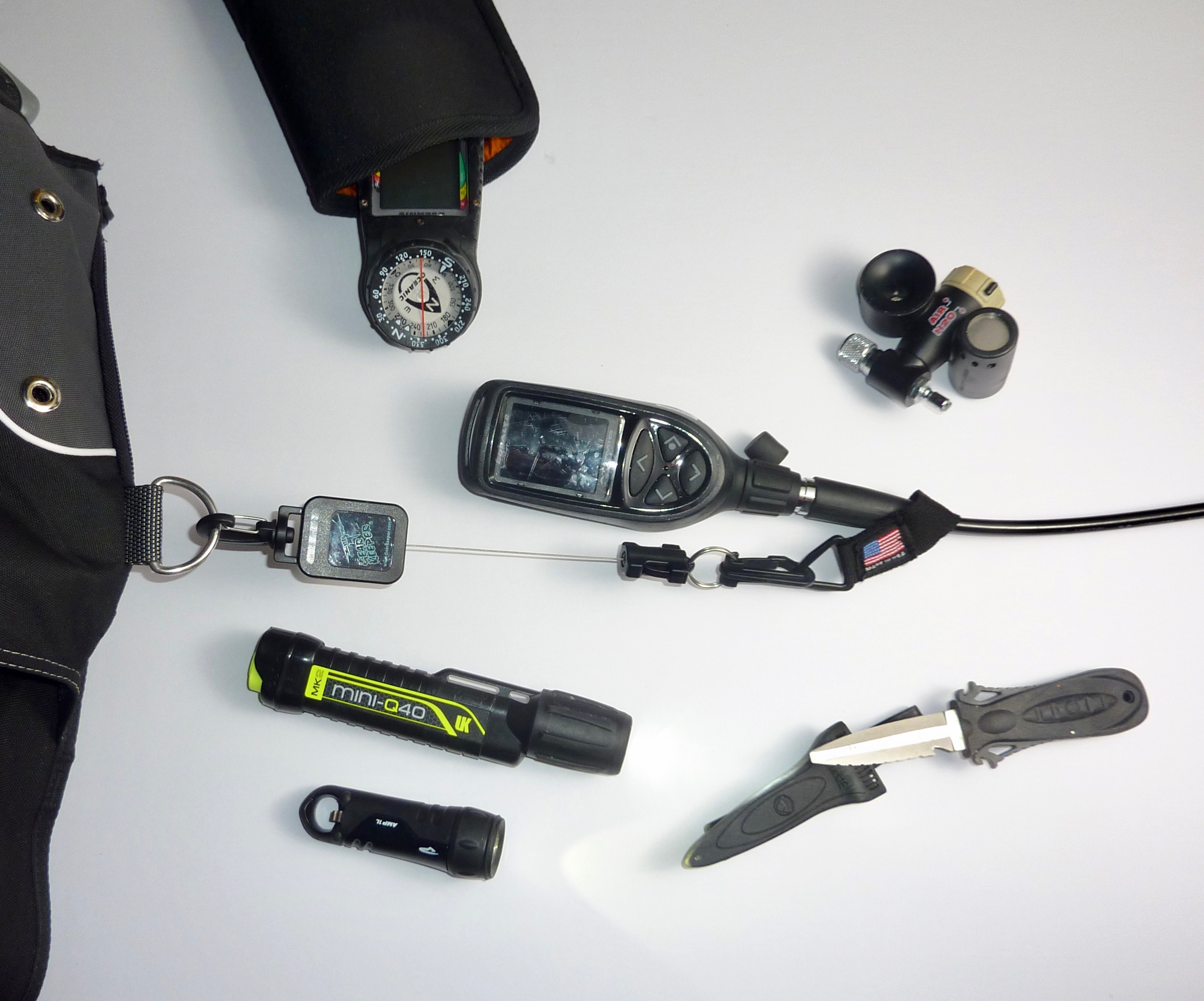If you think a dive console is simply a collection of gauges, you’re sorely mistaken. The console of the 21st century has become a dive information center, a way to plan dives and track their progress. It not only organizes several pieces of gear, but it should assist in organizing your dive THINKING. A good console will tell you your relative position in space and time. It will tell you where you’ve been, how long you’ve been there, where you should be going, and the time you’ve got left to stay there. Your console is “dive plan central.”
The elements included in a console, and how they are organized (and in some cases interact with one another) will impact greatly on the organization of your dive as it progresses underwater. The elements most often included in consoles today (in order of most important to least) include: pressure gauge, depth gauge, timer (the depth gauge and timer are most often now combined into a dive computer), compass, and thermometer.
In this article, we will look at these elements individually, what’s best, and finally how to combine them for your diving needs. But first, let’s look at a fundamental choice in gauging—digital vs. analog.
DIGITAL VS. ANALOG
In today’s digital world, it is easy to brush off analog as antiquated. Digital is a measurement and display in numbers or digits such as with most LCD displays on today’s dive computers. Analog is a round-face gauge with a needle that moves indicating the measurement desired. Both methods have their strength and weaknesses. Digital is easier to read and understand quickly. In cases with electronics, only a digital display is practical. Analog can be more accurate, particularly at smaller divisions such as shallow depths.
PRESSURE GAUGE
The submersible pressure gauge (SPG) is where the console got started in the late early 1970s. It simply told you, in p.s.i., how much pressure you had left in your tank. A big mental hurdle for beginners, even to this day, is that the amount of air you have left in your tank is not the same as pressure. The amount of air left in a 65 cubic foot at 500 p.s.i. is not the same as a 500 p.s.i. with a 100 cubic foot tank.
Most pressure gauges are not much different than those from the early ’70s. They are analog, a needle and dial, with the guts being a “burdon tube” which is a tube that expands and contracts according to pressure driving the needle and giving you the reading. It is low tech, quite reliable, and accurate.
Digital pressure gauges do exist and have one advantage. Tied to a dive computer, and with other information included such as tank size and depth, can give you a rough estimate of how much breathing gas time you have remaining.
DEPTH GAUGE AND DIVE TIMER
A measuring device for current depth and maximum depth, as well as elapsed dive time, is no most commonly combined in a dive computer. Many good basic dive consoles, however, are still available that show simply depth. The gauge is usually oil filled and reacts to ambient pressure increases. Generally analog, these gauges are accurate and durable. Get a gauge that has a way of measuring maximum depth. You will need a dive timer, usually a watch, that you monitor and compare against dive tables to monitor nitrogen uptake.
Modern dive computers are inexpensive and easy to use. They combine depth and dive time monitoring while calculating dive tables automatically for you. Entire article, even whole books, have been written about selecting dive computers. That will not be attempted here. One major factor needs to be kept in mind in your dive computers—simplicity and ease of use. Today’s dive computers are available with dozens of features, many useful, some not, and some that will simply confuse you. As you shop for a dive computer, look for device that you can understand and make function in basic ways in just a few minutes of trial and error in the dive store. The numbers should be large and easy to read. It should, at minimum record maximum depth reached, number of dives in last 12 hours, bottom time of current or most recent dive, time until it is safe to fly, no decompression dive time remaining and ascent rate monitor. Other features may include a “log” mode with records of previous dives (sometimes with the ability of download into a desktop computer), altitude compensation, nitrox programing, temperature, and, as mentioned before, air consumption.
COMPASS
Pressure gauge and depth gauge/dive timer are considered “must haves” for monitoring a dive’s progress. This author considers the dive compass nearly as important as the previously mentioned gauges. Many divers monitor their air consumption and depth and time well but don’t know where they are on the bottom. They then get themselves in trouble ascending far from the boat or beach. A good dive compass will have a large face, easy to read numbers, moving bezel and a side window for properly lining up on a landmark and running a course. But even the best compass needs a good operator. A full understanding of how to use a dive compass will make you a much better diver.
PUTTING IT ALL TOGETHER
By putting all the gauges together, a diver can monitor the progress of a dive in one glance—air pressure, depth, time, and direction. The best consoles do all this at once. All the gauges should be in a configuration so that all can be monitored at once, occupying only one hand to raise the console to a comfortable position for reading, yet not distracting terribly from the underwater scenery.









